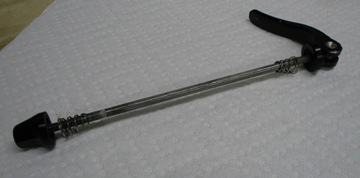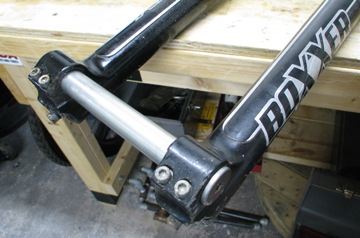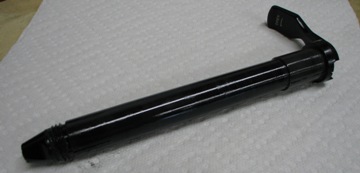|
There is talk in the bicycle industry
about killing off the 30+ year old QR Style release design system for
mountain bikes. Is this good, is this bad? In my opinion, this would be a
key advancement in axle technology and allow for a more secure and safe
option on installing your wheels…but this is my opinion.

The change has already begun. The days
of Thru Axles are not just for freeride or downhill bikes, but they are
finding there way on to XC trail bikes and even some of your cruiser models.
Since fork technology has advance over the past 6 years, lighter long-travel
forks have come to market promoting the use of Thru Axle designs. This
increased usage has also prompted the development of a better and faster
“quick release” option for Thru Axles forks.
What is a Thru Axle?
In short a Thru Axle design
incorporates a solid rod or hollowed shaft that passes directly through the
hub and both legs of the fork or rear frame members. It is then secured to
one side of the fork leg or rear frame member (typically on the brake rotor
side) by a threaded mechanical connection.

Thru Axle designs offer a stronger
more secure mechanical connection that is stiffer then a standard QR style
release system and safer with no worries about the skewer coming loose
during your ride. An additional benefit is consistent alignment of your
wheels and no need to ever wonder whether the skewer is tensioned enough.
Now, Thru Axles do weight more then a QR axle however the difference in
weight is minor (150 grams or less) when it comes down to aggressive trail
riding and security of your wheels not falling off or becoming loose.
Is there an Industry Standard?
As of today…NO! The industry is
somewhat working towards a standardized axle size(s), but both large and
small component manufacturers try to maintain there market niche by having
their own unique system. Also, axle length, diameter and available fork
suspension for Cruisers, XC, All-Mountain, Freeride…you get the point will
vary due to the application the bike is intended for.
There are a few standard sized axles
in the market place today that suspension and hub manufacturers are
maintaining. The majority of front axle sizes you will find in most bike
shops are 15mm or 20mm diameter fitted for a either a 100 or 110mm wide hub.
The rear hub has more variety ranging from 10 to 15mm axle diameter fitted
typically for a 135mm wide hub; however axle width will vary up to 160mm.
Other available axles that may be
considered specialty sizes for both front and or back hubs are 10mm, 19mm,
24mm and 25mm diameters; Axle width can vary depending on the manufacture
and whether there serving the US, Europe and or Asia Market place.
What does this all mean for YOU?
This can become an important and
costly factor whether you have one or multiple mountain bikes running either
a QR Style or Through-designed axle. Searching for a new hub, wheel set or
replacing a damaged axle can be difficult to wrap your head around if you’re
not aware of the axle type and size you currently have installed.
For individuals who have multiple
mountain bikes, the possibility you may be dealing with a number of
different axle designs is high unless they all have QR Style Release
Systems. There could be a different axle system on the same bike for either
the front or back wheel; or completely different across each of the bikes
you own. Either way it can cost you a fortune to maintain spare parts or
make them swappable especially if you have a “special” or not so common axle
design. Most riders find this problem when they damage a front wheel and
attempt to take the wheel from another bike just to find out the axles does
not fit.
Even if you only maintain one mountain
bike, you are not dismissed from the above situation. You may have a bunch
of spare parts and or back-up components that could limit your choice in
purchasing a new hub or fork solely based upon the axle type you have.
Although this matter will be much easier to handle, you may find yourself
settling for a product that you really did not want.
Are Thru-Axles for everyone?
In short…no! Not all mountain bikers
will need to upgrade to a Thru-Axle system unless the industry as a whole
decides the QR Style Release System is obsolete; but that is not happening
anytime soon.
Your everyday or casually rider who
treks on fire roads, smooth single-track or occasionally hits some technical
terrain would be satisfied with a QR release system. In fact most would not
even notice the benefits of having a Thru-Axle system due to the type of
riding.
In my opinion, mountain bikers who are
aggressive trail rides and gravity junkies should consider opting for
Thru-Axle frames and components if they have not already done so. The
benefits of a Thru-Axle far exceed that of a QR Style Release and this will
translate into a better ride experience.

Available options!
With the increasing use of Thru-Axles
for a wide range of mountain bikes, you may find yourself in a pickle when
it comes down to upgrading your older bike. There are very few reliably
options out there to make the jump from QR to Thru-Axles without breaking
the bank and purchasing a new bike.
On option is using convertible hubs or
wheel sets that permit you to change the end caps allowing the use of a QR
skew or Thru-Axle. However you will still need to make sure your bike frame
and or fork will accept the larger axle before you decide to purchase a
convertible hub or wheel-set.
A secondary option to use in
conjunction with convertible hubs is a bolt on axle. Bolt on axles will
typically fit within the drop-outs on your frame/fork and allow you to bolt
into a solid axle. However many older QR drop-outs were not design to handle
the increase stress that will occur when you crank down that bolt to tighten
the axle. This may damage your drop-out making the fork or frame junk.
If you’re in the market for a new
mountain bike and your trail riding is moving towards or already is
aggressive, you should consider opting for a bike with Thru-Axles both front
and back. You will definitely notice the benefits and performance out of the
box and have much more confidence when hitting a technical section.
Posted By: Diesel
Date: 09/30/2009 |